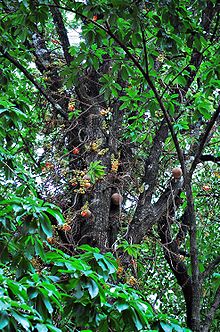- Couroupita guianensis
-
Cannon-ball tree 
Couroupita guianensis, flower Conservation status Scientific classification Kingdom: Plantae (unranked): Angiosperms (unranked): Eudicots (unranked): Asterids Order: Ericales Family: Lecythidaceae Genus: Couroupita Species: C. guianensis Binomial name Couroupita guianensis
Aubl.Couroupita guianensis, whose common names include Ayahuma and the Cannonball Tree, is an evergreen tree allied to the Brazil Nut (Bertholletia excelsa), and is native to tropical northern South America and to the southern Caribbean. In India it has been growing for the past two or three thousand years at least, as attested by textual records[citation needed]; hence it is possible that it is native to India also. It's part of the family Lecythidaceae and grows up to 25m (82ft) in height. The "Cannonball Tree" is so called because of its brown cannon-ball-like fruits. The majority of these trees outside their natural environment have been planted as a botanical curiosity, as they grow very large, distinctive flowers. Its flowers are orange, scarlet and pink in color, and form large bunches measuring up to 3m in length. They produce large spherical and woody fruits ranging from 15 to 24cm in diameter, containing up to 200 or 300 seeds apiece.
Contents
Discovery
The Cannonball Tree was given its species name Couroupita guianensis by the French botanist J.F. Aublet in 1755.
Locations
The Cannonball Tree is native to the tropical forests of northeastern South America, especially the Amazon Basin and in the tropics such as in India and Thailand.
Flowers and pollination
Cannonball Tree flowers do not have nectar, so these flowers are mainly visited by bees in search of pollen; outside the native range of habitat, carpenter bees are considered to be the principal pollinators. Both the fruit and the flower grow from stalks which sprout from the trunk of the tree. Cannonball Tree flowers are found on thick tangled extrusions that grow on the trunk of the tree; these are found just below the foliage branches. The extrusions however, can range from two to six feet in length. The flowers are attached to an upwardly bent, white fleshy disk. The flowers have six petals, which are large, orange-red, and strongly perfumed. In pollination, fertile stamens can be found in a ring around reduced style and stamens. The sterile pollen is located in the anthers. As a bee enters to pollinate the flower, its back rubs against the ring with fertile pollen; this allows the bee to carry the fertile pollen to another flower. The differences in the pollen was noticed by French botanist Antoine Porteau in 1825. The differences in the pollen are as follows: the pollen of the ring stamens is fertile, while the hood pollen is sterile.
Fruits and dispersal
The tree gets its common name from the large, spherical fruits it produces. The fruit falls from the tree and cracks open when it hits the ground when mature, often causing the sound of a small explosion. The fruit emits an unpleasant aroma when exposed to the air. Individual seeds within the "ball" are coated with hair, which is thought to protect the seed when it is ingested and may also help in the passage of the seed through the intestines. Like coconut palms, the trees should not be planted near paths or near traffic-filled areas, as the heavy nut is known to fall without notice.
Religious Significance in Asia
The trees are grown extensively in Shiva temples in India. In Hindi it is called Shiv Kamal and also known as "Kailaspati". It is called the Nagalingam tree in Tamil. The flowers are called Shivalinga flowers in Hindi; Nagalinga Pushpa in Kannada; Nagamalli flowers or Mallikarjuna flowers in Telugu. Hindus revere it as a sacred tree because the petals of the flower resemble the hood of the Naga, a sacred snake, protecting a Shiva Lingam, the stigma.
In Sri Lanka, Thailand and other Buddhist countries the tree is often planted at Buddhist temples. It is here mistaken as the Sala tree, Shorea robusta, the tree under which the Buddha passed away and under which the previous Buddha Vessabhu attained enlightenment.
Medicinal Uses
The Cannonball Tree possesses antibiotic, antifungal, antiseptic and analgesic qualities. The trees are used to cure colds and stomach aches. Juice made from the leaves is used to cure skin diseases, and shamans of South America have even used tree parts for treating malaria. The inside of the fruit can disinfect wounds and young leaves ease toothache[citation needed].
References
- Mitré (1998). Couroupita guianensis. 2006. IUCN Red List of Threatened Species. IUCN 2006. www.iucnredlist.org. Retrieved on 6 May 2006.
External links
- Couroupita guianensis on The Lecythidaceae Pages
- [1] on mukthabalaga.wordpress.com
Categories:- IUCN Red List least concern species
- Lecythidaceae
- Trees of Costa Rica
- Trees of Panama
- Trees of French Guiana
- Trees of Guyana
- Trees of Suriname
- Trees of Venezuela
- Trees of Brazil
- Trees of Colombia
- Trees of Ecuador
- Trees of Peru
- Least concern plants
Wikimedia Foundation. 2010.


